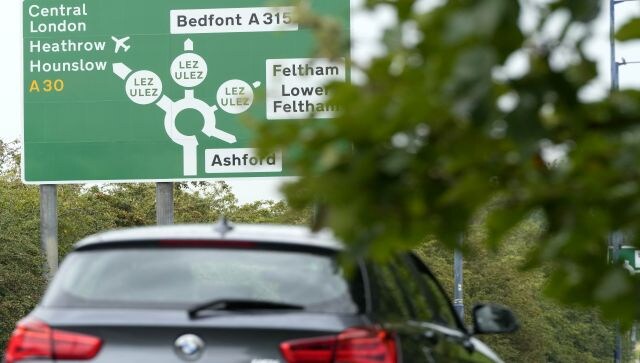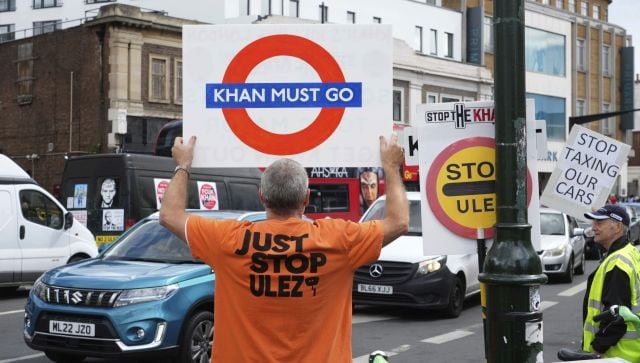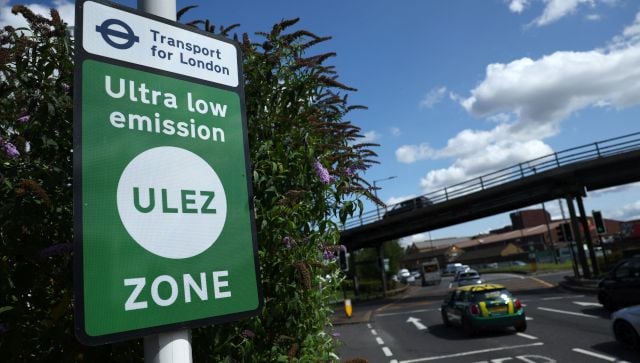No City for Polluting Cars: What are London’s controversial clean air zones?
No City for Polluting Cars: What are London’s controversial clean air zones?

London has big plans to crack down on older, polluting vehicles. Starting today, owners of these cars will face a charge to drive anywhere in the city. It is all part of the expansion of the Ultra-Low Emission Zone (Ulez), which aims to improve the air quality in the United Kingdom. But car pollution is likely to continue as usual. London mayor Sadiq Khan has reportedly shelved the plan for zero emissions after facing backlash and receiving no support from Prime Minister Rishi Sunak.
We take a look at the clean air scheme and the controversy surrounding it.
What is the Ultra-Low Emission Zone (Ulez)?
The ultra-low emission zone was introduced in London by Mayor Sajid Khan in 2019 as a measure to tackle the growing air pollution in the city. The policy was chalked out when Boris Johnson was the mayor.
The plan at first covered only some areas in central London but it was expanded to the north and south circular roads in 2021. In November 2022, it was confirmed that all boroughs would fall under Ulez, a change which was to come into effect from 29 August 2023.
The plan has now been dropped, according to a report by Financial Times (FT). But if implemented it would be the biggest change on the roads of the capital in years and would affect millions of drivers. Heathrow Airport was scheduled to be included, which meant that those driving from other parts of the city would be affected.
The vehicles that do not follow the rules and drive in the zones have to pay a charge of £12.50 (Rs 1,305) a day to Transport for London (TfL), which manages the scheme. If Ulez is applied to all roads in the capital, nearly 7,00,000 car drivers in Greater London face paying the fine.

Why were these zones introduced?
Like all big cities, London has a toxic air problem. The low-emission zones were introduced to clean up the air and make the environment healthier.
The scheme aimed at reducing two air pollutants emitted by petrol and diesel vehicles nitrogen dioxide (NOx) and fine particulate matter (PM2.5), which are blamed for premature deaths and affecting the growth of children’s lungs, according to a report by the BBC.
According to Khan, Ulez is “transformational” and he claimed extending it meant that “5 million more people will be able to breathe cleaner air and live healthier lives”. He said that the expansion will reduce deaths from illnesses linked to air pollution and help to curb climate change.
Why is Khan facing backlash over Ulez?
The scheme became an issue in a by-election in two constituencies which would be affected by the plan for a larger zone. In fact, the uproar over the Ulez has been blamed for the Labour Party’s failure to win the by-polls in the outer London constituency of Uxbridge. This is despite opinion polls predicting a big lead for the main opposition party.
The matter also went to court. However, in July, the high court dismissed a legal challenge by five Conservative-led councils against the expansion plan, ruling it lawful.
There have also been public protests against the scheme. London’s traffic cameras are under attack. Police say hundreds of licence plate-reading cameras have been damaged, disconnected or stolen by opponents of an anti-pollution charge on older vehicles, reports The Associated Press.
“The cameras are going to keep coming down,” predicted Nick Arlett, who has organised protests against the clean-air charge and says he neither condones nor condemns the sabotage “People are angry.”

Businesses and politicians have opposed the policy. Critics say it puts an additional financial burden on people at a time when the UK is facing a cost-of-living crisis.
The UK government has refused to support the Ulez scheme, as it argues that powers over transport and air quality are devolved to the capital, reports The Guardian. British prime minister Rishi Sunak has delayed and in some cases abandoned green policies that have a direct impact on consumers.
In July, Sunak urged the London mayor to “think twice” on the plans to expand the zones. He told the BBC that the penalties were an “unnecessary extra tax” when inflation was “causing a hassle”. He added it would “burden” on families when they “visit the supermarket, take their kids to school, go to see their GP”.
On Monday, Sadiq Khan said that Sunak had put decades of progress on clean air into reverse” and now risks “stunting the lungs” of London’s children by failing to support the expansion of the capital’s ultra-low emissions zone. However, a report in FT said that Khan shelved plans for a zero-emission zone in central London.

Why has Sadiq Khan dropped the plan?
As the London mayor faced criticism over the decision to expand Ulez, his office confirmed that it had dropped the plan so that it could focus on reaching the capital’s net zero emissions by 2030, the report says.
According to Khan’s spokesperson, while the zero emission zone plan had been shelved, individual London boroughs could implement their schemes with support from Transport for London. “TfL continues to support boroughs who wish to implement zero emission zones in their local areas… The mayor is rolling out some of the most ambitious policies of any city in the world to clean up London’s air, including the expansion of the ultra-low emission zone, bringing cleaner air to 5 million more Londoners,” they said, according to a report in FT.
Have Ulez benefitted London?
The number of polluting vehicles which have entered Ulez has fallen drastically, reports the BBC. About 97 per cent meet the cleaner standards. In these zones, NOx emissions have fallen by 26 per cent since 2019 with PM2.5 emissions falling by 19 per cent over the same period.
The air quality has improved but the levels of both pollutants in the capital city still exceed World Health Organisation guidelines.
Do other cities have such policies?
Cities in the UK like Bath, Birmingham, Portsmouth, and Sheffield, among others have clean air zones. Paris has a zero-emission zone plan for 2030, reports BBC.
Cities in Italy and Germany also have similar zones.
With inputs from agencies
What's Your Reaction?



























































